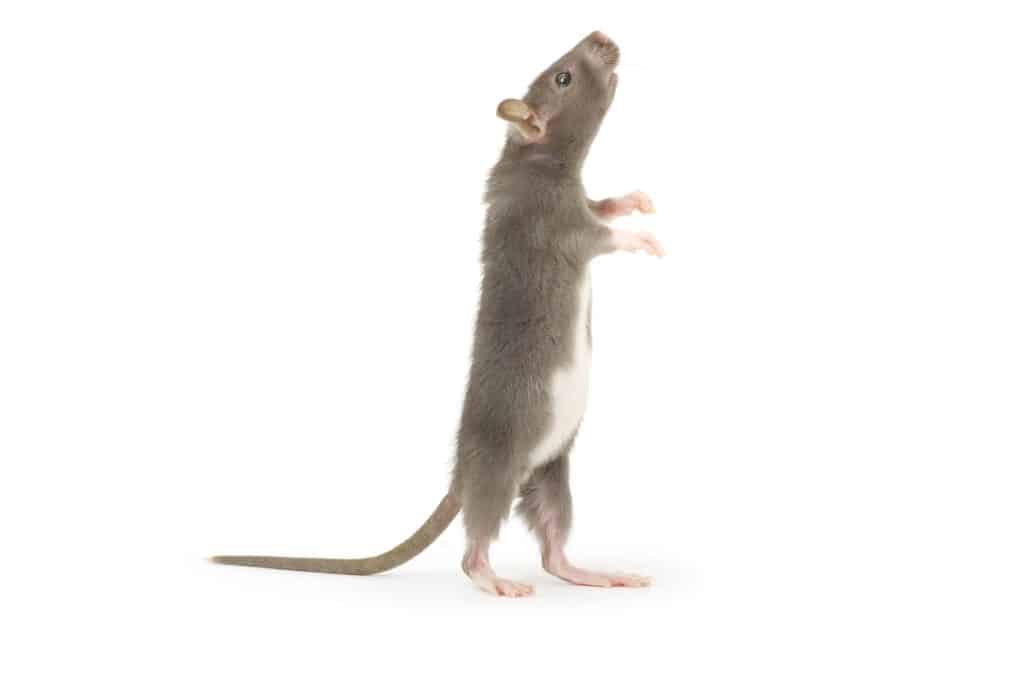While mice and rats share some physical characteristics, their differences are quite noticeable when you know what to look for. Here’s how they compare:
One of the most apparent differences is size. Mice are much smaller, typically ranging from 6.4 to 10.2 cm / 2.5 to 4 inches in length, excluding the tail, and weigh only about 14 grams / half an ounce. Their bodies are slender, allowing them to squeeze into tight spaces easily.

In contrast, rats are much larger, with bodies measuring between 17.8 to 22.9 cm / 7 to 9 inches and weighing around 340 to 454 grams / 12 to 16 ounces. Their bulkier appearance and thicker bodies make it easier to differentiate them from their smaller cousins.

The tails of these rodents also vary significantly. A mouse’s tail is generally as long as or longer than its body, featuring a fine, smooth texture. In comparison, rat tails are shorter than their body length, appearing thicker and covered in visible scales.
Mice have large, prominent ears relative to their head size and small, beady eyes. Their large ears help them detect sounds in their environment. Rats, on the other hand, have smaller ears in proportion to their heads and more noticeable, protruding eyes, giving them a somewhat intimidating look.
Rats are equally versatile but tend to favour different environments based on their species. Norway rats, also known as brown rats, are commonly found in sewers, drains, and lower levels of buildings. They prefer burrowing in the ground and are often associated with poor sanitation areas. Roof rats, on the other hand, are more likely to be found in elevated locations such as attics, trees, and upper levels of buildings. These rats are adept climbers and can use overgrown vegetation to access homes. Understanding these habitat preferences is key to effective pest control in Winnipeg, as it helps in locating and eliminating their nesting sites.
Understanding the behavioural differences and habits of these rodents can offer clues about which type you may be dealing with. Each species has unique feeding preferences, nesting habits, and activity patterns.
Mice are nibblers. They tend to eat small amounts of food, usually preferring grains, seeds, and sweets. Because they eat only a little at a time, you may notice partially chewed food items around the home.
Rats, however, have a heartier appetite. They consume more food in a single sitting and are less picky about what they eat. Rats are omnivorous and will feed on anything from meat scraps to grains.
When it comes to nesting, mice prefer to stay close to their food sources. They typically build nests in soft materials like paper, fabric, or insulation, often in hidden places such as wall voids or attic spaces.
Rats are more resourceful with their nesting choices. Norway rats prefer burrowing in the ground, while roof rats often nest in high places like trees or attics. They can adapt their nests based on available materials and surroundings, making them harder to locate.
Mice and rats are both nocturnal, meaning they are most active during the night. However, mice are curious creatures and tend to explore their surroundings often, even if it puts them at risk. Rats are more cautious and may take several days to become familiar with new objects or food sources.
Identifying the type of rodent infestation is crucial for effective treatment. Here’s how to tell whether you’re dealing with mice or rats:
Beyond being a nuisance, mice and rats can pose significant health risks to humans. These rodents carry diseases that can be transmitted directly or indirectly through their droppings, urine, or bites.
Mice can spread diseases such as Hantavirus, Lymphocytic Choriomeningitis (LCMV), and Salmonella. Hantavirus, for example, can be transmitted through inhaling dust contaminated with mouse droppings or urine, leading to severe respiratory issues. LCMV, on the other hand, is typically spread through contact with mouse saliva or urine and can cause neurological problems in severe cases.
Rats can carry diseases like Leptospirosis, Rat-bite fever, and Bubonic plague. Leptospirosis can be contracted through contact with water or soil contaminated with infected rat urine. Rat-bite fever, as the name suggests, is spread through bites or scratches from an infected rat. Although rare today, the Bubonic plague was historically transmitted by fleas that infested rats.
Taking steps to prevent an infestation before it happens is the best way to avoid the health risks and damage caused by rodents. Here are some practical tips for mouse and rat prevention:
Sometimes, DIY measures may not be enough, especially if the infestation is severe. If you notice persistent signs of rodents, extensive property damage, or health concerns, it's best to call A1 Pest Solutions Inc. It can assess the situation, identify the rodent species, and implement an effective treatment plan.
Knowing the differences between mice and rats is more than just a fun fact—it’s essential for protecting your home and health. While mice are smaller and tend to nibble on grains, rats are larger, more cautious, and will eat just about anything. Both pests can pose serious health risks if left unchecked, so being able to identify the signs of an infestation is crucial.
Preventative measures like sealing entry points and proper food storage can make a big difference. However, if you find yourself dealing with a stubborn infestation, don't hesitate to seek professional help.
Take action today to protect your home from these unwelcome guests. If you're struggling with a rodent problem, contact A1 Pest Solutions Inc for a thorough inspection and personalized solution.